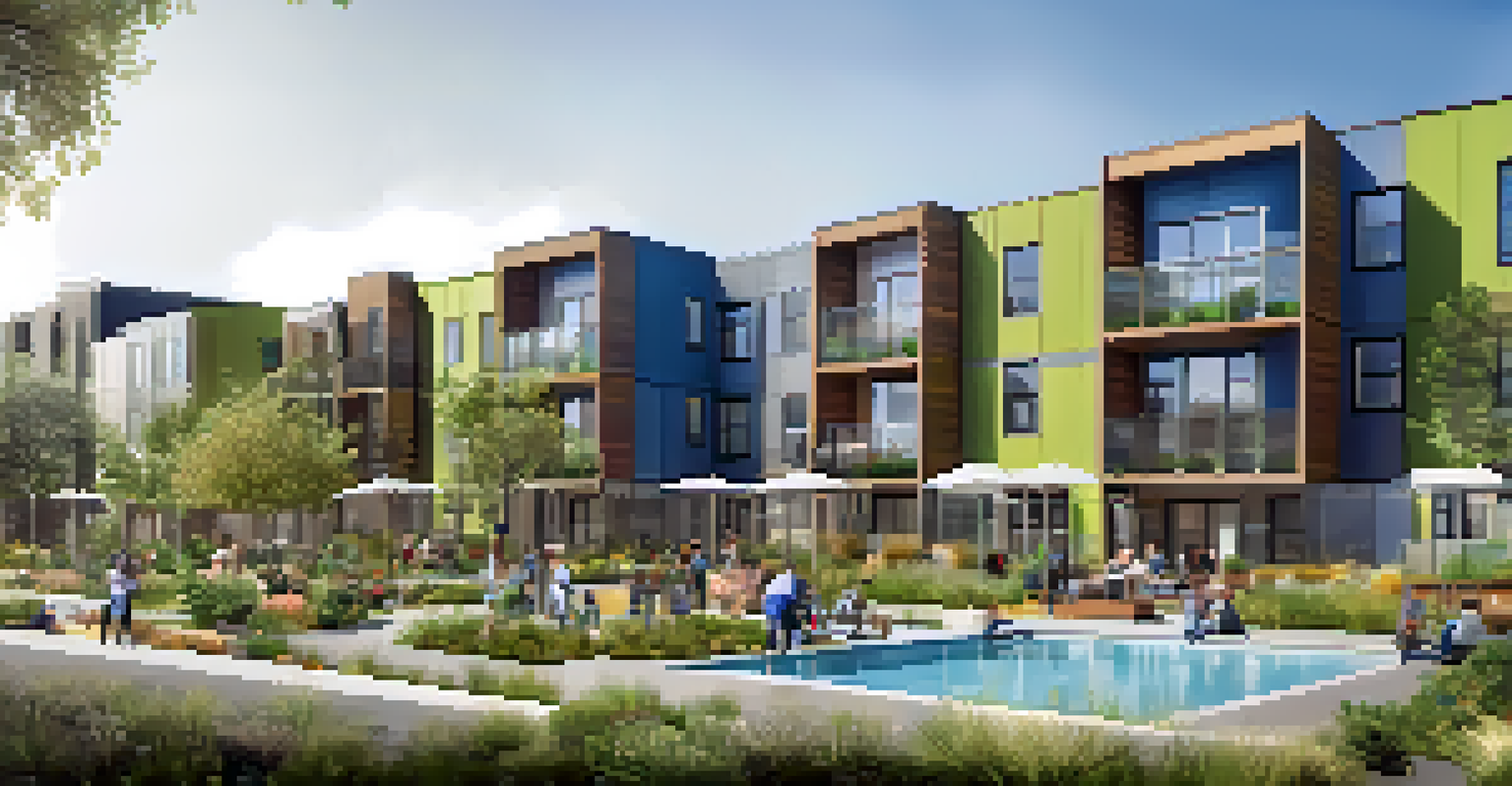Affordable Housing Initiatives: A Look at LA's Recent Developments

Understanding Affordable Housing in Los Angeles
Affordable housing refers to homes that are affordable to low and moderate-income individuals. In Los Angeles, this is a pressing issue, as the cost of living continues to escalate. Many residents find themselves spending more than 30% of their income on housing, which is considered a threshold for affordability. The city has recognized this challenge and is actively seeking solutions to provide more accessible housing options.
Housing is absolutely essential to human flourishing. Without stable shelter, it all falls apart.
The importance of affordable housing cannot be overstated. It not only provides shelter but also contributes to the stability of families and communities. When people have secure and affordable places to live, they are more likely to thrive in other areas of life, such as education and employment. Thus, LA's efforts to bolster affordable housing are crucial for the overall health of the city.
In recent years, various initiatives have emerged to tackle this issue head-on. From public-private partnerships to innovative funding strategies, Los Angeles is exploring diverse avenues to increase the availability of affordable homes. These initiatives aim to create a more inclusive city where everyone has access to safe and affordable living conditions.
Recent Developments in Affordable Housing Projects
Los Angeles has seen a surge in new affordable housing developments, thanks to a combination of city policies and community advocacy. Initiatives such as Measure HHH, passed in 2016, have provided funding for the construction of supportive housing for the homeless. This measure has catalyzed numerous projects across the city, addressing both homelessness and the need for affordable units.

One notable development is the 'The Flower Street Apartments', which offer a mix of affordable units for families and individuals. These types of developments are designed with community needs in mind, providing not just housing but also access to services that promote stability. Such projects demonstrate a comprehensive approach to affordable housing that seeks to empower residents.
Need for Affordable Housing
Los Angeles faces a significant challenge as many residents spend over 30% of their income on housing, highlighting the urgent need for affordable options.
Moreover, the city is focusing on zoning reforms to streamline the approval process for new housing projects. By reducing bureaucratic hurdles, Los Angeles aims to expedite the construction of affordable units. This proactive stance is essential in a city where the demand for housing continues to outpace supply.
Community Involvement in Housing Initiatives
Community involvement plays a vital role in the success of affordable housing initiatives. Residents often have valuable insights into what their neighborhoods need, and their participation can lead to more effective solutions. In Los Angeles, various community organizations are working alongside the city to advocate for affordable housing and ensure that developments meet local needs.
The best way to solve the housing crisis is to build more homes, not less.
For example, community meetings and workshops allow residents to voice their concerns and preferences regarding new housing projects. This collaborative approach fosters a sense of ownership and inclusivity, ensuring that new developments reflect the community's character. Involving residents in the planning process can also mitigate potential pushback against new projects.
Additionally, neighborhood councils and advocacy groups are crucial in monitoring the implementation of affordable housing projects. They hold developers accountable and push for transparency in how funds are allocated. This grassroots involvement not only strengthens community bonds but also enhances the overall effectiveness of housing policies.
Innovative Funding Models for Affordable Housing
Funding is often the biggest hurdle in the development of affordable housing. However, Los Angeles is exploring innovative funding models to overcome this challenge. One such model is the use of tax credits, which incentivize private developers to invest in affordable housing projects. This partnership between the public and private sectors can lead to more sustainable solutions.
Another approach is the establishment of community land trusts, where land is purchased and held by a nonprofit organization. This model ensures that the land remains affordable for future generations, as it removes the property from the speculative real estate market. By prioritizing long-term affordability, community land trusts can help stabilize neighborhoods and provide much-needed housing.
Community Engagement is Key
Involving local residents in the planning process ensures that affordable housing developments meet community needs and foster a sense of ownership.
Moreover, Los Angeles is tapping into federal and state resources to bolster its housing initiatives. Programs like the Low-Income Housing Tax Credit (LIHTC) have proven effective in financing affordable housing. By leveraging these resources, the city can expand its efforts and create more opportunities for residents to secure affordable homes.
Challenges Facing Affordable Housing Efforts
Despite the positive developments in affordable housing, challenges remain. One significant issue is the NIMBY (Not In My Backyard) phenomenon, where residents oppose new housing projects in their neighborhoods. This resistance can slow down the approval process and limit the number of affordable units being built. Understanding and addressing these concerns is essential for moving forward.
Additionally, funding limitations can hinder the scale and speed of affordable housing developments. While initiatives like Measure HHH have made strides, ongoing financial support is critical to sustain these efforts. The city must continuously seek innovative funding solutions to ensure that affordable housing remains a priority.
Lastly, the balance between development and neighborhood preservation is a delicate dance. While new housing is essential, it's equally important to respect the character and needs of existing communities. Striking this balance will be key to ensuring that affordable housing initiatives are both effective and well-received.
The Role of Technology in Housing Solutions
Technology is reshaping many industries, and housing is no exception. In Los Angeles, tech innovations are being harnessed to streamline the development process and enhance affordability. For example, digital platforms can facilitate better communication between developers, city officials, and community members, leading to more efficient project planning.
Moreover, construction technology is advancing rapidly, with prefabrication and modular building techniques gaining traction. These methods not only reduce construction time but can also lower costs, making affordable housing more achievable. By embracing these innovations, LA can potentially increase the number of affordable units available to its residents.
Innovative Funding Solutions
Los Angeles is exploring creative funding models, such as tax credits and community land trusts, to support the development of affordable housing.
Additionally, technology is being used to analyze housing data, helping policymakers make informed decisions. By understanding housing trends and demographics, the city can better tailor its initiatives to meet the specific needs of its communities. This data-driven approach can lead to more effective and sustainable housing solutions.
Looking Ahead: The Future of Affordable Housing in LA
As Los Angeles continues to navigate its housing crisis, the future of affordable housing looks promising yet challenging. With ongoing community engagement and innovative funding models, there is potential for significant progress. The city's commitment to expanding affordable options reflects a growing awareness of the importance of housing stability for its residents.
Moreover, as technology continues to play a larger role, we may see more creative solutions emerging. From enhanced construction methods to data-driven policymaking, these advancements could help address the complex challenges of affordable housing. The key will be to remain adaptable and responsive to the ever-changing landscape of housing needs.

Ultimately, the success of affordable housing initiatives will depend on collaboration among all stakeholders. By fostering partnerships between the city, developers, and community members, Los Angeles can create a more inclusive and equitable housing market. Together, they can work towards a future where everyone has a place to call home.